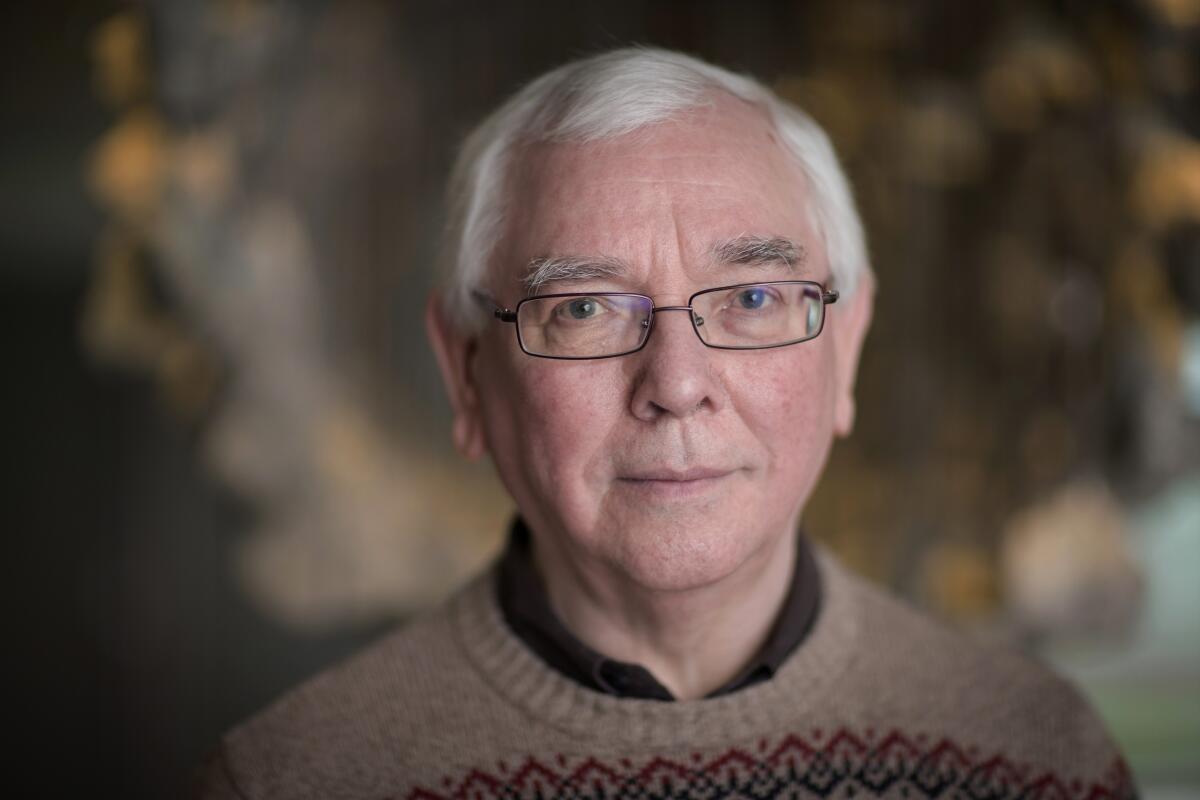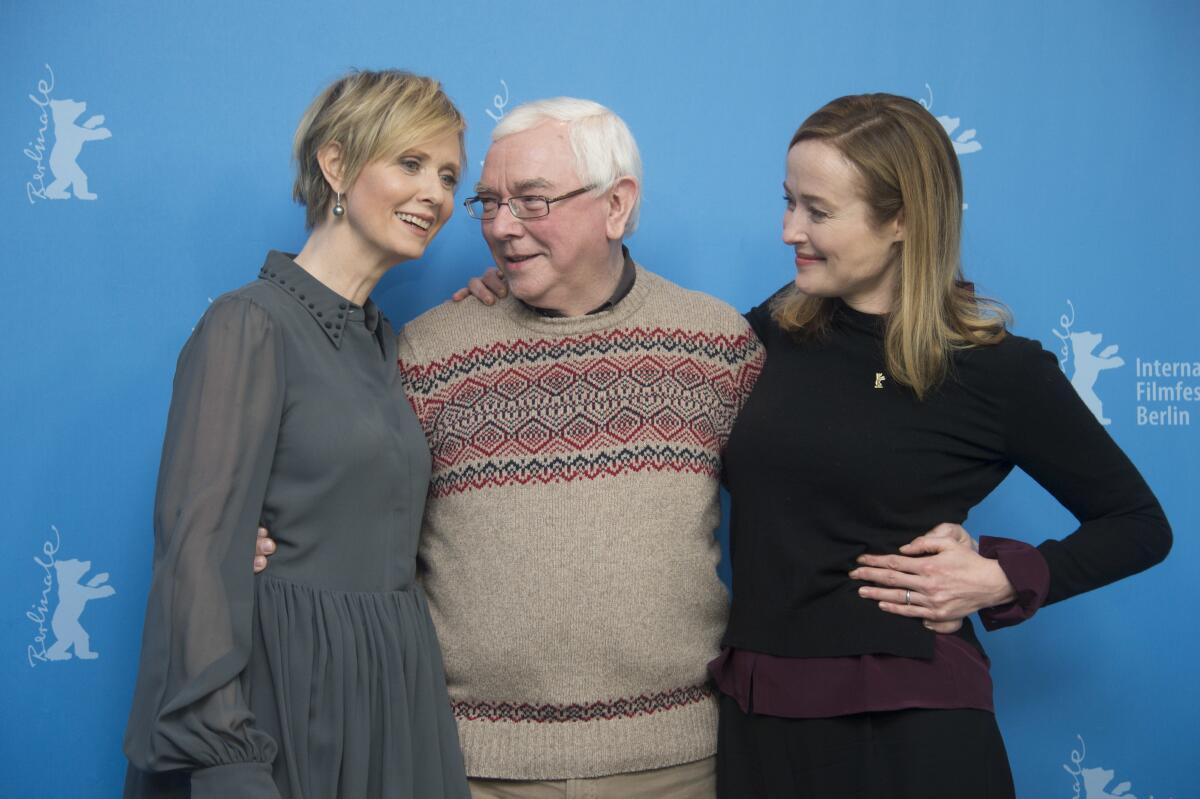Appreciation: Terence Davies, a master filmmaker, brought quiet passion and lyrical beauty to the screen

In the very last scene of Terence Davies’ “Benediction” (2021), a World War I veteran sits on a bench and weeps, descending into an anguish so deep and consuming that not even his copious tears can properly express it. We see the tears but don’t hear the sobs; instead the music surges extravagantly on the soundtrack, almost as if it were reaching heavenward, in search of a divine consolation that the man himself may never know.
This is the British poet Siegfried Sassoon (played by Jack Lowden), and he is broken by the death of the fellow soldier he loved, and also by the wartime horrors that he witnessed, some of which will give shape and subject to his writing. But in this moment, Sassoon is also a Davies character like so many others: a figure not only brought low but also strangely exalted by his grief and his passion. The sheer intensity of the filmmaker’s gaze seems to illuminate his tragedy from within, elevating it into something tender and magisterial, a tableau of transcendence.

It is hard to watch that sequence now without weeping anew, for both Sassoon and the director who memorialized him. Davies died on Saturday at the age of 77, and to say that “Benediction” is an apt (and aptly titled) final work is an accurate yet painfully inadequate response to his passing. For a director who began his career with a series of semi-autobiographical masterworks, there is something fitting about the fact that his last opus achieved such a personal match of filmmaker and subject. Which is not to make too much of any similarities between Davies and Sassoon, gay English artists who lived through distinct (if comparably repressive) eras, and who had markedly different relationships with their Catholicism. Over the years, Davies, a longtime celibate, was outspoken in interviews about his hatred of his own sexuality; he leveled similar hostility against a Church whose strictures he could never fully shake, even long after he had renounced his belief in God.
But art thrives on contradictions, and the age-old tensions between faith and desire, between dogmatic formalism and wild, unruly feeling, were precisely what made Davies such a magnificently expressive artist. The bitterness that he could pour into his words, rather than festering or calcifying on-screen, instead bloomed into something fully felt, vividly textured and often indescribably beautiful. And from the beginning, that beauty took on an intimately confessional form. Davies was born in 1945, and his first several movies, starting with the short-film trilogy of “Children” (1976), “Madonna and Child” (1980) and “Death and Transfiguration” (1983), were inspired and indelibly shaped by his postwar Liverpool upbringing.
His luminous first two features, “Distant Voices, Still Lives” (1988) and “The Long Day Closes” (1992), are records of the scars wrought by privation, poverty and a violently abusive father. But in these fragmentary, transporting memory pieces, we also see consoling glimmers of warmth, humor and sometimes joyous remembrance — and with them, the early signs of a lifelong devotion to art. (Years later, he would memorably enshrine his love for Liverpool in 2008’s “Of Time and the City,” his one and only documentary.)

Music, the lifeblood of Davies’ cinema, courses and cascades through these movies, forging a mesmerizing emotional continuity. In “Distant Voices, Still Lives,” a melancholy choral performance of “In the Bleak Midwinter” marks the passage of several family Christmas celebrations. In the opening scenes of “The Long Day Closes,” Nat King Cole croons out at us from the depths of a rain-drenched Liverpool alley, his radio-filtered voice practically drawing us backward, along with the steady glide of the camera, into the past. That film also pays tribute to the formative influence of Davies’ movie love, exalted in overheard snippets from classic films like “Kind Hearts and Coronets,” “The Magnificent Ambersons” and “Great Expectations” — the beginnings of a love affair with cinema that would sustain and transform him.
Davies’ love for classic Hollywood, while profound, never manifested itself obviously in his own work. After his semi-autobiographical films put him on the map, he made his first leap into American filmmaking with “The Neon Bible” (1995), his under-appreciated adaptation of John Kennedy Toole’s novel starring Gena Rowlands. Reviewing the movie for The Times, the critic Kevin Thomas rightly described it as “not like any other period coming-of-age-in-the-South movies you’ve ever seen.” Appreciating just how radically Davies had bent the material toward his own memory-play conceits, Thomas may have also pinpointed why moviegoers — many of whom are thoroughly uninterested in seeing things they’ve never seen — would stay away. And indeed Davies, so often greeted with critical love and audience indifference, would struggle to get his projects financed for the rest of his career.

Part of what distinguishes Davies’ stories has always been the unfashionable stateliness of their telling, their quality of contemplation. For the uninitiated, the precision of his compositions, the graceful drift of his camera movements and the fastidiousness of his musical choices can seem restrained to the point of stiffness. Don’t be fooled; Davies trusts us to bridge the distance he places between us and his characters, and it’s precisely his formal composure that makes his pictures so enveloping, lyrical and finally overwhelming in their dramatic force. In a drama as masterfully realized as “The House of Mirth,” his 2000 adaptation of Edith Wharton’s novel, Davies’ filmmaking rigor takes on the fury of an indictment — a repudiation of the rigidly stratified early-20th-century New York in which Lily Bart, a socialite in search of a husband, is pursued, mocked, betrayed and finally, systematically destroyed.
“The House of Mirth” remains my favorite of Davies’ films for many reasons, from its air of tragic futility and inevitability to the spare, ghostly beauty of its mise-en-scène, which resists Merchant-Ivory sumptuousness at every turn. Most of all, it features a stunning performance by Gillian Anderson, whose skill at period drama we take for granted now; back in 2000, when she was still best known for “The X-Files,” her turn as the doomed, dithering Lily Bart, peering out slyly from beneath veiled hats and disgorging seductive whorls of cigarette smoke, carried the force of revelation. Her performance was also a powerful testament to Davies’ skill with actors — a command he would demonstrate again with Agyness Deyn in “Sunset Song,” his beautiful adaptation of Lewis Grassic Gibbon’s novel; Cynthia Nixon in “A Quiet Passion,” his ferociously witty portrait of the poet Emily Dickinson; and also with Rachel Weisz in “The Deep Blue Sea,” a gloriously florid screen version of Terence Rattigan’s stage melodrama set in postwar England.

Weisz won the New York Film Critics Circle’s best actress award for her performance as Hester, a woman torn between wealth and poverty, between an unexciting older husband and a fickle younger lover, between the will to go on and the suicidal impulses that refuse to leave her alone. She is, like Lily Bart and other tragic Davies protagonists, a consummate outsider, someone who has willed herself — nobly, and perhaps a little foolishly — into a kind of sustained banishment from conventional society. Davies loved his outsiders, in part because he knew so well what it meant to be one. But watch his movies (and they reward multiple viewings) and you will also see generous expressions of solidarity, of reminders that we are seldom as alone as we might think.
The Emily Dickinson of “A Quiet Passion” both exasperates and is exasperated by her tightly cloistered family, but the love and respect that courses among them is never in doubt. The Sassoon of “Benediction” finds community — fleeting and fickle, but precious nonetheless — in a sphere of gay artists whose work earned them a degree of renown and refuge. And during a flashback to the Blitz in “The Deep Blue Sea,” the camera pans along a train platform where Hester and hundreds of other Londoners have taken refuge, raising their voices in an impromptu “Molly Malone” sing-along. It’s among the most gorgeous moments ever crafted by a filmmaker who excelled at turning his memories into cinema, and whose cinema deserves to be long remembered.
More to Read
Only good movies
Get the Indie Focus newsletter, Mark Olsen's weekly guide to the world of cinema.
You may occasionally receive promotional content from the Los Angeles Times.







